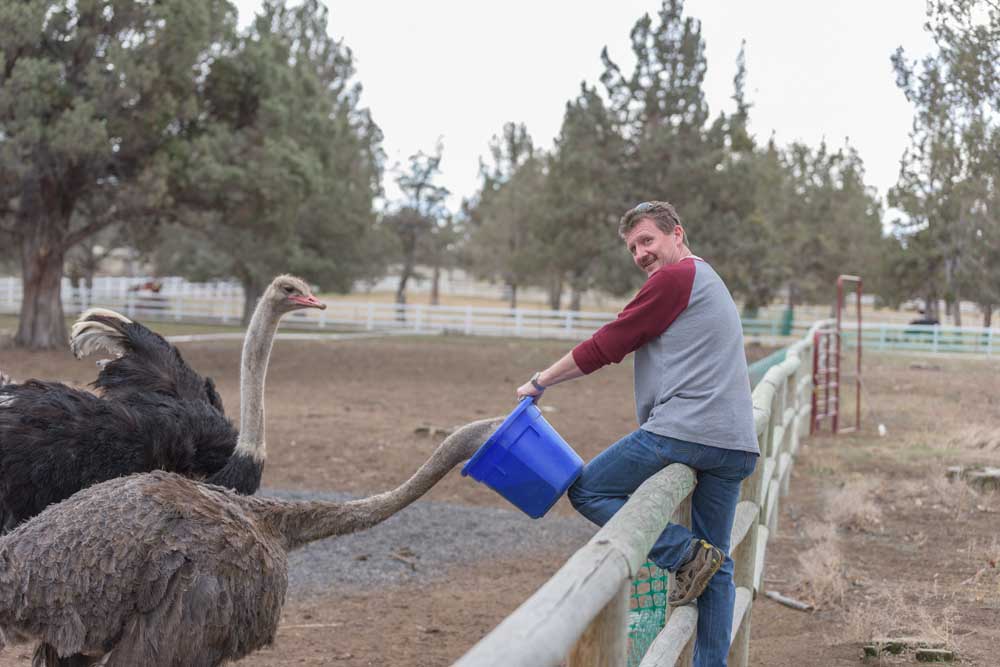Big Bird
Published 12:00 am Saturday, March 5, 2016

- Big Bird
The American ostrich market has always been a quirky sign of economic times. It first peaked in the late 1800s, when ostrich feathers made a pricey fashion statement. The second ostrich craze of the 1980s and 1990s — when a living pair of the gawky, flightless birds could sell for up to $20,000 — burned out not long before the “dot-com bust.”
One Oregon family believes the ostrich can make another comeback with more lasting effect because consumer attitudes have evolved.
Michael and Danielle Lehman own and operate Central Oregon Ostrich, a 30-acre ranch near the Deschutes River in south Redmond.
“A lot has changed since the 80s and 90s. Back then, people didn’t seem to be as concerned about things they’re really focusing on now,” he said.
Among those concerns are climate change, the corporatization of farming, and the mistreatment and doping of livestock. The Lehmans’ farming methods address these concerns by treating the environment and their animals with respect. Their operation produces almost no methane, a harmful greenhouse gas produced by some types of high-density ranching. The Lehmans don’t give their birds antibiotics, but they do give them plenty of fresh air and room to roam.
“We provide the birds as natural a setting as possible,” Lehman said.
Ostrich are often seen huddling together with their heads down looking for food on the ground. This tendency explains why they have a reputation for burying their heads in the sand when scared, which Lehman said is a myth.
“When ostriches are scared, they don’t bury their heads, they run,” he explained.
Ostrich can weigh up to 350 pounds and run as fast as 40 miles per hour, so in large groups, they can knock down fences and trample other ostrich.
Central Oregon Ostrich raises its birds from eggs laid by their own birds. Typically an ostrich is ready to harvest when it’s just over a year old. Lehman said that keeping their birds alive until harvest requires keeping the chicks separate from the adults. Ostrich, he explained, have poor somatosensation, meaning they have very little awareness of what their large bodies are doing. As a result, they can accidentally kill their offspring.
“In the wild, young ostrich have a 10 percent survival rate, but not primarily because of predation,” Lehman said. “It’s because they’re getting stepped on, sat on, starved out, and smothered by their own kind.”
While exotic meats are often likened to chicken, ostrich is much closer to beef in terms of taste, texture and color. Like beef, it’s high in protein and iron, yet it’s up to 97 percent lean and some cuts are also a tad sweeter than beef.
Lehman sells his meat wholesale for $7 to $20 per pound, whereas the National Cattlemen’s Beef Association website lists wholesale beef price range from $2 to $10 per pound.
The ostrich business is healthy, but can it fly? Unlike the birds themselves, the market for their meat could really take off according to Geoff Latham of Nicky USA, a Portland-based specialty meat distributor.
“The demand for ostrich meat is way higher than the supply,” Latham said, adding that he buys all the Lehman’s meat which they don’t sell themselves, and still has customers asking for more. “We sell out every year before we get to the next harvest.”
Nicky USA’s customers include restaurants and households looking for a lean alternative to beef. Latham said the meat they get from Central Oregon Ostrich sells on word-of-mouth alone.
“We don’t do a lot of promotion for it … we don’t have to,” he said, adding that he believes he’ll soon be showcasing ostrich on a larger scale. “Every year they’re giving us more and more. The Lehmans are bringing back big bird.”
Central Oregon Ostrich sold the meat of seven birds — roughly 700 pounds — in 2015, and they’re aiming for 21 birds this year. Next year they hope to grow up to 60 birds. Lehman said they have the space to comfortably manage as many as 300. He doesn’t sell live birds, but if he did, he would expect to get up to $2,500 for an adult breeder pair, far less than he could have received in the ‘80s and ‘90s when speculation for future meat demand drove prices sky-high.
Hard work and determination will play a big part in the success of Central Oregon Ostrich, but Lehman said he believes other factors are at play as well. For one, he explained, the ostrich industry as a whole needs to grow in order for their own business to enjoy the benefits of scale.
Still Lehman believes he and Danielle are poised for success.
“It’s not a function of people not wanting ostrich meat. They just can’t get it,” he said. “We, and hopefully other ranchers, are going to change that.”








